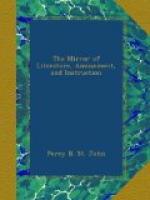are so irregular that it is not worth while to collect
the water of them in cisterns, as is done in Syria.
The terraces are concealed from view by slight parapet
walls; for throughout the east, it is reckoned discreditable
that a man should appear upon the terrace, whence
he might be accused of looking at women in the neighbouring
houses, as the females pass much of their time on the
terraces, employed in various domestic occupations,
such as drying corn, hanging up linen, &c. The
Europeans of Aleppo alone enjoy the privilege of frequenting
their terraces, which are often beautifully built of
stone; here they resort during the summer evenings,
and often to sup and pass the night. All the
houses of the Mekkawys, except those of the principal
and richest inhabitants, are constructed for the accommodation
of lodgers, being divided into many apartments, separated
from each other, and each consisting of a sitting-room
and a small kitchen. Since the pilgrimage, which
has begun to decline, (this happened before the Wahaby
conquest,) many of the Mekkawys, no longer deriving
profit from the letting of their lodgings, found themselves
unable to afford the expense of repairs; and thus
numerous buildings in the out-skirts have fallen completely
into ruin, and the town itself exhibits in every street
houses rapidly decaying. I saw only one of recent
construction; it was in the quarter of El Shebeyka,
belonged to a Sherif, and cost, as report said, one
hundred and fifty purses; such a house might have been
built at Cairo for sixty purses.
The streets are all unpaved; and in summer time the
sand and dust in them are as great a nuisance as the
mud is in the rainy season, during which they are
scarcely passable after a shower; for in the interior
of the town the water does not run off, but remains
till it is dried up. It may be ascribed to the
destructive rains, which, though of shorter duration
than in other tropical countries, fall with considerable
violence, that no ancient buildings are found in Mekka.
The mosque itself has undergone so many repairs under
different sultans, that it may be called a modern
structure; and of the houses, I do not think there
exists one older than four centuries; it is not, therefore,
in this place, that the traveller must look for interesting
specimens of architecture or such beautiful remains
of Saracenic structures as are still admired in Syria,
Egypt, Barbary, and Spain. In this respect the
ancient and far-famed Mekka is surpassed by the smallest
provincial towns of Syria or Egypt. The same
may be said with respect to Medina, and I suspect that
the towns of Yemen are generally poor in architectural
remains.




